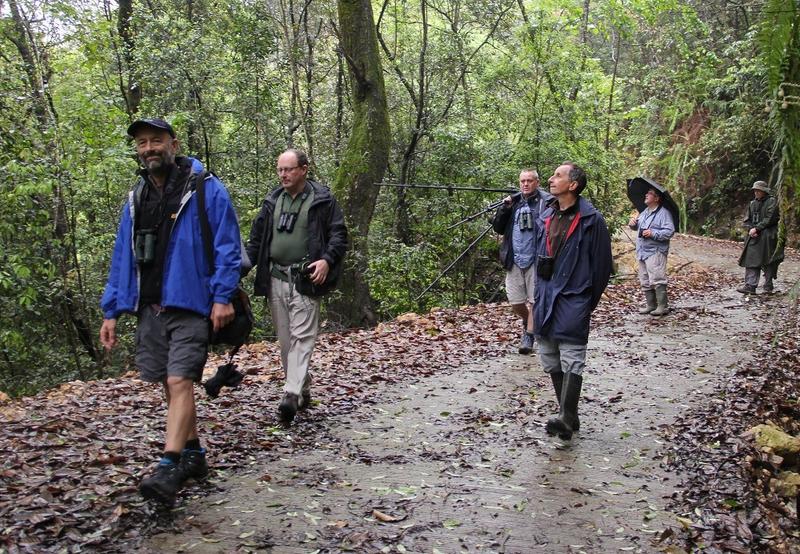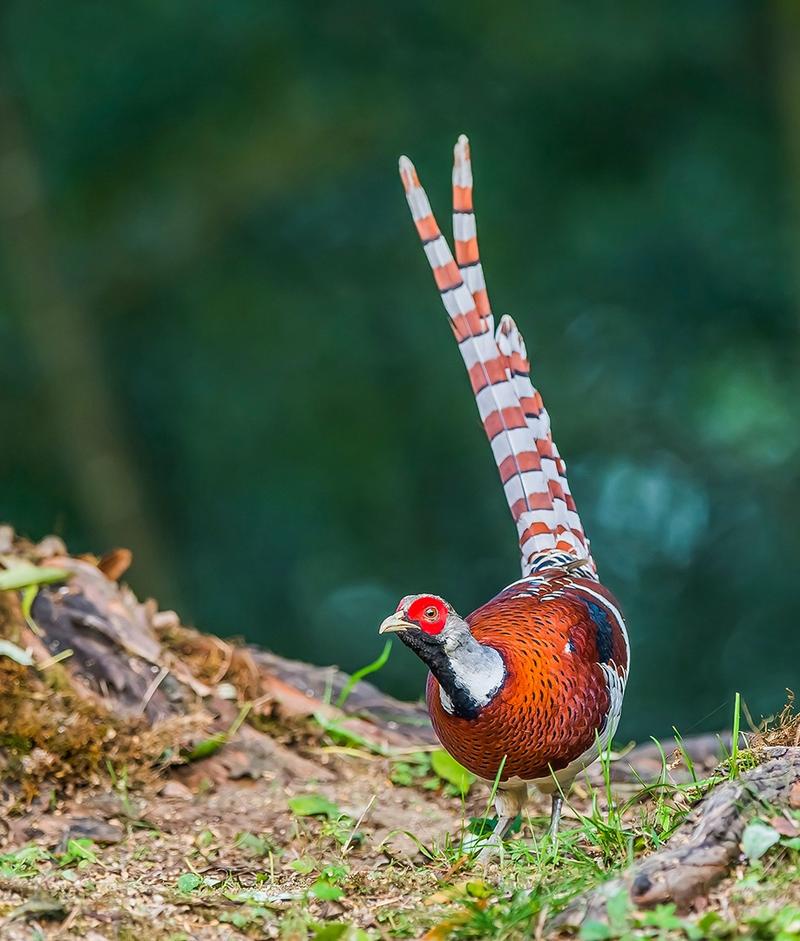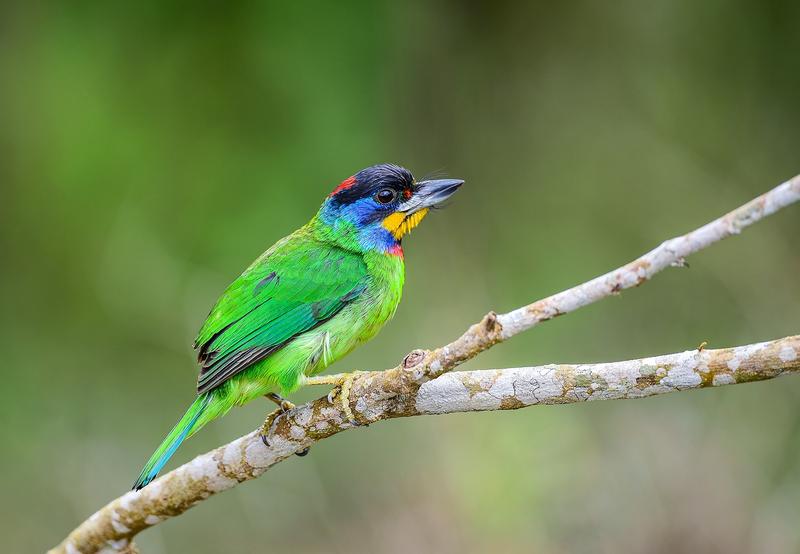County on major migratory route is mixing bird-watching with local tourism, report Yang Feiyue in Beijing and Hu Meidong in Fuzhou.
 Yang Meilin ushers a group of silver pheasants. (PHOTO PROVIDED TO CHINA DAILY)
Yang Meilin ushers a group of silver pheasants. (PHOTO PROVIDED TO CHINA DAILY)
A hushed whisper quickly passed around Zhang Feng and his friends the moment a rare bird landed, in full bloom, right before their very eyes, or at least their telephoto lens. The event occurred during his recent trip to Ziyun village, Mingxi county, Fujian province.
Zhang's years of photographing birds had him quickly pinpoint its identity as Tragopan caboti, affectionately called "giant panda" by bird lovers for their rare numbers. Then, an intense staccato from the clicks of camera shutters arose, as Zhang and his photographer friends tried to capture the bird's exotic postures through their lens.
Ideal ecological conditions, with forest coverage exceeding 90 percent, gives Ziyun an appealing charm, especially for birds. The village has seen some 93 species of birds, which in turn draw ornithologists from across the country.
"We've been here a lot," says Zhang.
Ever since Ziyun launched bird sightseeing in 2016, people who share Zhang's interest in the feathered friends have taken to the village.
 College students learn to make the Hakka snack ciba, a glutinous rice delicacy, in Mingxi county, Fujian province. (PHOTO PROVIDED TO CHINA DAILY)
College students learn to make the Hakka snack ciba, a glutinous rice delicacy, in Mingxi county, Fujian province. (PHOTO PROVIDED TO CHINA DAILY)
Mingxi county is on a major migratory route, between East Asia and Australasia, and boasts more than 300 wild birds, including 64 under first- and second-class national protection programs. Some species, including the white-necked long-tailed Elliot's pheasant, the greater painted snipe and oriental dollarbird, are a treat for the eye.
It has been the county government's major focus to explore ways of bird protection. More than a decade ago, it was common for local villagers to hunt birds for food. Since 2015, the county has taken a series of measures to protect birds and restore their habitats. Efforts have been made to publicize bird preservation and develop a bird rescue mechanism and a migrant birds intelligent monitoring and management system.
Such efforts have paved the way for the smooth development of the ecological bird observation industry. Locals have turned from hunters into guardians.
Yang Meilin, a villager from Ziyun, has come up with ways of protecting birds, especially the silver pheasants, over the years.
Yang, in his late 70s, has grown a fondness for birds after he accidentally found some feeding on grains in his farmhouse a few years ago.
"They are very cute, with the white feathers and long tails," he says.
 Birdwatchers in Mingxi are transfixed by their latest sighting. (PHOTO PROVIDED TO CHINA DAILY)
Birdwatchers in Mingxi are transfixed by their latest sighting. (PHOTO PROVIDED TO CHINA DAILY)
Yang gets up early in the morning and goes into the woods to scatter grain on a daily basis. He then imitates the bird voice, which draws out silver pheasants to feed, especially during winter, when finding food can be tough in the natural setting. Yang has rescued injured birds and gotten them professional help when treating serious cases before releasing them back into the wilderness.
Under the local authority's guidance, Yang has turned his rural house and those of some others he rented in his village into homestays and a bird observatory that offers distinctive local food and other services to photographers and travelers. Yang's grandchildren have joined the business integrating bird-watching with tourism. In 2016, they set up infrared cameras to detect the habits of birds, built a concealed birdwatching shed, and made arrangements for visitors to better engage in photo and video shoots.
When observing birds, Yang reminds tourists not to smoke, lower their voices and mute their phones to avoid disturbing the birds or damaging the environment. Before the pandemic, Yang's homestays received about 8,000 guests from more than 30 countries every year.
"They love the birds, especially those endemic species with distinctive characteristics," Yang says.
 European birdwatchers in Mingxi on the trail, literally, of their feathered friends. (PHOTO PROVIDED TO CHINA DAILY)
European birdwatchers in Mingxi on the trail, literally, of their feathered friends. (PHOTO PROVIDED TO CHINA DAILY)
Yang is one of the many residents in Mingxi that have benefited from this local tourism drive. The county authority has developed five birdwatching facilities and several travel routes, based on the distribution of bird species for tourists. An overall bird map has been developed to allow visitors to find birds they like.
Such efforts have seen an increase in the number of visitors to the county, and given rise to opportunities in catering, homestay business, guide and driving services.
In Ziyun, an ecological tourism company has been founded and cooperation with institutes of higher learning fostered to achieve quality ecological tours, rural research and learning experiences.
So far, the village has developed 18 observation sites to watch birds and trained some 11 villagers for guest pickup and delivery services. Four bird-themed homestays are up and running. More than 70 villagers have managed to find jobs in Ziyun and the village's per capita annual income has increased by 35,000 yuan ($5,220), according to the village authority.
"Our 15 rooms have usually been booked during weekends since May," says Shen Xiaozhen, who runs a homestay in Ziyun.
Most of his guests are from counties and cities nearby and stay for more than 10 days exploring nature.
 An Elliot's pheasant examines its surroundings in the lush forest. (PHOTO PROVIDED TO CHINA DAILY)
An Elliot's pheasant examines its surroundings in the lush forest. (PHOTO PROVIDED TO CHINA DAILY)
In addition to Ziyun, four other villages in the county have developed bird-watching cooperatives to share the benefits brought by birds and their visitors.
In Danshang village, about two hours from Ziyun, more than 40 villagers joined the bird-themed tourism cooperative in 2017. They accounted for 80 percent of the shares with their investment and labor input, while the village committee accounted for the rest 20 percent.
In 2019, the cooperative yielded a dividend of 62,000 yuan, it said.
The positive changes have also helped preserve the environment and biodiversity in Mingxi, which has drawn attention from outside the area. As a result, Beijing Forestry University, Fujian Agriculture and Forestry University, and the country's biggest wild bird photography website birdnet.cn, have all set up teaching and internship faculties in Mingxi. Lectures, exhibitions and photography competitions have been held, including the 2020 Cabot's Tragopan Cup international bird photography competition, which further put the county on the map of bird lovers.
 A black-browed barbet takes a well-deserved rest on a tree branch. (PHOTO PROVIDED TO CHINA DAILY)
A black-browed barbet takes a well-deserved rest on a tree branch. (PHOTO PROVIDED TO CHINA DAILY)
Approximately 30,000 travelers visit Mingxi every year. More than 1,000 people have joined businesses that are related to bird-watching, such as summer camps and traditional Chinese medicine service.
During 2020-21, the turnover of the county's forest preservation facilities reached 137.84 million yuan, contributing 12.25 million yuan in taxes.
Chen Lin, a senior member of the China Wildlife Conservation Association, has witnessed the changes in Ziyun. The village abounds in birds and locals have developed an awareness of protecting them, Chen says. Ecological protection and birdwatching have developed in Fujian after years of exploration, and the future prospects look good, he adds.
In the future, bird-watching will be further integrated with local culture tourism resources, according to the Mingxi forestry bureau. A long-term cooperation mechanism with academic institutes and the association will be established, and management will be standardized to host bird-themed cultural forums and photography competitions. The idea is to extend the birdwatching industry and boost Mingxi's development through ecology, according to the county forestry bureau.
Yang Jie contributed to this story.
Contact the writers at yangfeiyue@chinadaily.com.cn


